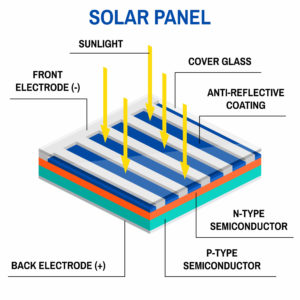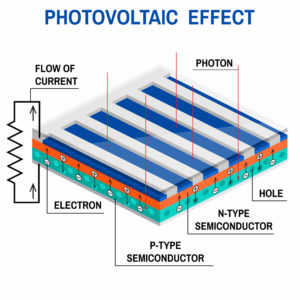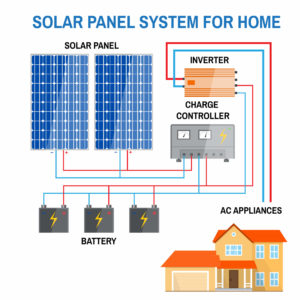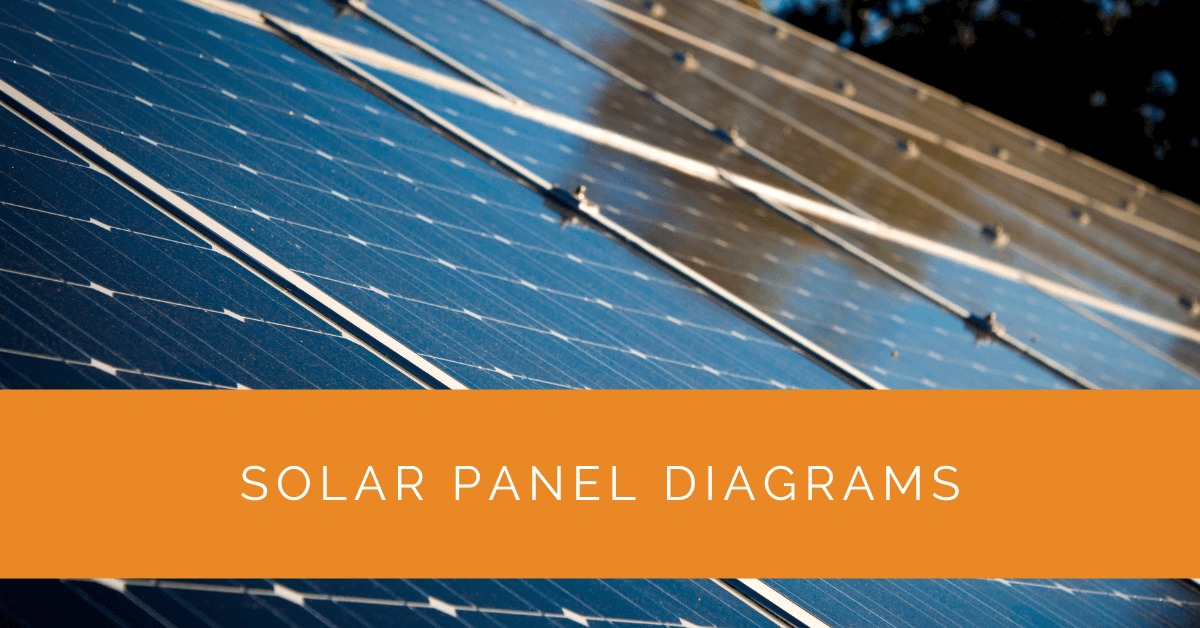Solar panels are essential to solar energy systems, harnessing the sun’s power to generate electricity. Understanding the various components and how they work together is crucial for efficient solar panel installations. In this article, we will delve into the details of solar panel diagrams, exploring the key components and their functions.
Contents
Solar Panel Diagram

The solar panel diagram depicts the intricate arrangement of various components that combine to convert sunlight into electricity. Let’s delve into each component and understand its role in the solar panel system.
Sunlight: The Power Source
Sunlight is the fundamental source of energy for solar panels. When sunlight reaches the solar panel, it contains countless photons, which carry energy that can be harnessed.
Cover Glass: Protection and Light Transmission
The cover glass serves as a protective layer for the solar panel. It shields the delicate solar cells from external elements such as dust, moisture, and physical damage. Moreover, the cover glass is designed to transmit as much light as possible to ensure optimal light absorption by the solar cells.
Anti-reflective Coating: Enhancing Efficiency
An anti-reflective coating is applied to the cover glass to maximize the amount of light absorbed by the solar cells. This coating reduces reflection, allowing more incident light to penetrate the solar panel and reach the solar cells. By minimizing light reflection, the anti-reflective coating enhances the overall efficiency of the solar panel.
N-type Semiconductor: Electron Donor
Solar cells contain a layer of N-type semiconductor material. This material is doped with impurities that provide an excess of free electrons. When photons strike the N-type semiconductor, they excite the electrons, initiating the flow of electric current.
P-type Semiconductor: Electron Acceptor
Adjacent to the N-type semiconductor is a layer of P-type semiconductor material. The P-type material is also doped with impurities but of a different type, creating a deficiency of electrons. This creates a positive charge in the P-type material, called “holes.” The P-type semiconductor attracts the free electrons from the N-type material, completing the circuit and facilitating the flow of electric current.
Front Electrode (-): Electron Collection
The front electrode, typically made of a conductive material like silver or aluminum, acts as the negative terminal of the solar cell. It collects the free electrons generated by the absorption of photons and provides a path for them to flow out of the solar cell.
Back Electrode (+): Hole Collection
The back electrode, often made of a conductive material like copper or stainless steel, acts as the positive terminal of the solar cell. It collects the positively charged holes created when electrons move from the N-type to the P-type material. The back electrode ensures the completion of the circuit, allowing the flow of electric current.
By understanding the intricate details of a solar panel diagram, we can appreciate each component’s role in converting sunlight into usable electricity.
Photovoltaic Effect Diagram

The photovoltaic effect is the underlying phenomenon that enables solar panels to generate electricity. Let’s explore the components involved in this effect and understand their functions.
Photon: The Energy Carrier
Photons, the particles of light, are energy carriers in the photovoltaic effect. When sunlight reaches the solar panel, it consists of numerous photons with varying energy levels. These photons interact with the solar cells, transferring their energy to the electrons within the material.
Hole: Positive Charge Carrier
When a photon transfers its energy to an electron in the semiconductor material, the electron is excited and leaves behind a positively charged space called a hole. The presence of holes contributes to generating electric current within the solar cell.
N-type Semiconductor: Electron Source
The N-type semiconductor material in the solar cell provides an abundance of free electrons. When excited by the energy from photons, these electrons become mobile, creating a surplus of negatively charged particles ready to contribute to the flow of electric current.
P-type Semiconductor: Hole Acceptor
Adjacent to the N-type semiconductor is a layer of P-type semiconductor material. The P-type material contains impurities that create a deficiency of electrons, resulting in a surplus of positively charged holes. These holes attract and accept the free electrons from the N-type material, facilitating the flow of electric current.
Electron: Current Carrier
Electrons, as negatively charged particles, play a crucial role in the photovoltaic effect. When excited by photons and freed from their atomic bonds, these electrons become mobile and move toward the P-type material. As they flow through the circuit, they contribute to generating electric current.
Flow of Current: Harnessing the Energy
The movement of electrons through the circuit constitutes the flow of electric current. This current can be directed to power various electrical devices or stored in batteries for later use. By capturing and utilizing the flow of electrons, solar panels convert the energy of sunlight into a usable form of electricity.
Understanding the intricate details of the photovoltaic effect helps us appreciate the remarkable process by which solar panels generate electricity from sunlight.
Solar Panel System For Home Diagram

A solar panel system for residential applications involves several components working together to maximize energy production and utilization. Let’s explore the diagram of a solar panel system for homes and understand the function of each component.
Solar Panel: Capturing Sunlight
The solar panel, typically composed of multiple interconnected solar cells, is the primary energy-generating component. It absorbs sunlight and converts it into direct current (DC) electricity through the photovoltaic effect.
Inverter: Converting DC to AC
The DC electricity generated by the solar panels needs to be converted into alternating current (AC) electricity to power common household appliances and connect to the electrical grid. The inverter performs this crucial conversion, ensuring compatibility between the solar panel system and the home’s electrical infrastructure.
Charger Controller: Optimal Battery Charging
A charger controller plays a vital role in off-grid solar systems or systems with battery backup. It regulates the charging process of batteries, ensuring efficient and safe charging. The charger controller prevents overcharging, which can damage the batteries, and optimizes the battery charging based on the solar energy available.
Battery: Storing Excess Energy
Batteries play a crucial role in storing the excess electricity generated by the solar panels. They provide a reliable power source during low sunlight or power outages. By storing surplus energy, batteries ensure a consistent and uninterrupted power supply, maximizing the self-sufficiency and resilience of the solar panel system.
AC Appliances: Powering Household Devices
Most home appliances, such as refrigerators, televisions, and air conditioners, operate on AC electricity. In conjunction with the inverter, the solar panel system supplies AC power to these appliances, allowing them to function seamlessly using clean and renewable energy.
Case Study: Designing and Implementing a Residential Solar Panel System
Background
At Solar Panels Network USA, we prioritize delivering comprehensive solar solutions that meet our clients’ unique energy needs. This case study explores the process of designing and implementing a solar panel system for a residential property, emphasizing the importance of understanding solar panel diagrams and their components.
Project Overview
Our client, a homeowner interested in transitioning to renewable energy, sought a detailed understanding of how a solar panel system works. They wanted an efficient and reliable system that could power their home and reduce reliance on the electrical grid.
Implementation
Initial Assessment
We began by conducting an energy audit of the client’s home to determine their energy consumption patterns. This step was crucial for designing a system that would meet their needs effectively.
Explaining Solar Panel Diagrams
We provided the client with detailed solar panel diagrams, explaining each component’s function:
- Solar Panels: Capturing sunlight and converting it into direct current (DC) electricity.
- Inverter: Converting DC electricity into alternating current (AC) electricity for household use.
- Charger Controller: Regulating battery charging to prevent overcharging and optimize efficiency.
- Battery Storage: Storing excess energy for use during low sunlight or power outages.
- AC Appliances: Powering household devices with the converted AC electricity.
System Design
Based on the energy audit, we designed a system that included high-efficiency solar panels, a robust inverter, and a sufficient battery storage capacity. The design ensured that the solar panels could capture maximum sunlight and the system could store and distribute energy effectively.
Installation
The installation process involved:
- Positioning the Solar Panels: Ensuring optimal sunlight exposure by positioning the panels on the roof at the best angle.
- Connecting the Inverter and Charger Controller: Ensuring seamless conversion and regulation of electricity.
- Setting Up Battery Storage: Installing batteries in a safe, accessible location for efficient energy storage.
- Integrating AC Appliances: Connecting the system to the home’s electrical infrastructure to power all necessary appliances.
Testing and Optimization:
After installation, we conducted thorough testing to ensure the system operated efficiently. We monitored the energy production, conversion, and storage processes to identify and address any issues.
Results
The implemented solar panel system significantly reduced the client’s reliance on the grid, providing a reliable and sustainable energy source.
- Efficient Energy Production: The solar panels captured and converted sunlight effectively, consistently generating sufficient electricity to meet the household’s needs.
- Reliable Energy Storage: The battery storage system ensured a stable power supply during cloudy days and nighttime, enhancing the home’s energy resilience.
- Client Satisfaction: The client was delighted with the system’s performance and appreciated the clear explanation of the solar panel diagrams and components. They felt empowered to make informed decisions about their energy usage and management.
Summary
This case study highlights the importance of understanding solar panel diagrams for designing and implementing an efficient solar energy system. By grasping the functions of each component and their interplay, homeowners can optimize their solar investments and achieve sustainable energy independence. At Solar Panels Network USA, we are committed to providing expert guidance and high-quality installations that meet our clients’ energy needs.
Expert Insights From Our Solar Panel Installers About Solar Panel Diagrams
Understanding the components and how they work together is crucial for an efficient solar panel installation. Each part, from the cover glass to the semiconductors, plays a vital role in converting sunlight into electricity.
Senior Solar Technician
The photovoltaic effect is fascinating. It’s amazing how photons interacting with semiconductors can generate a flow of electricity. This fundamental process powers everything from homes to large solar farms.
Lead Installer
Proper system design, including the placement and connection of inverters and batteries, ensures that solar panels operate at peak efficiency. This knowledge is essential for anyone looking to maximize their solar investment.
Solar Energy Consultant
Experience Solar Excellence with Us!
Trust in Solar Panels Network USA, where our seasoned experts deliver top-quality solar solutions for homes and businesses nationwide. With a legacy of countless successful installations and a commitment to sustainable energy, we’re your reliable partner in the solar journey. Ready for a brighter, eco-friendly future? Call us now at (855) 427-0058 and harness the power of the sun!
Conclusion
Solar panel diagrams provide valuable insights into the intricate workings of solar energy systems. By understanding the components and their functions, individuals can make informed decisions when installing solar panels for their homes or other applications.
Whether it’s the solar panel diagram itself, the photovoltaic effect diagram, or the diagram representing a solar panel system for a home, each component plays a vital role in harnessing solar energy and converting it into usable electricity.
By grasping the fundamentals of solar panel diagrams, individuals can ensure optimal system performance, efficient energy production, and a more sustainable way of meeting their electricity needs.
About the Author
Solar Panels Network USA stands at the forefront of solar energy solutions, driven by a team of seasoned solar engineers and energy consultants. With over decades of experience in delivering high-quality solar installations and maintenance, we are committed to promoting sustainable energy through customer-centric, tailored solutions. Our articles reflect this commitment, crafted collaboratively by experts to provide accurate, up-to-date insights into solar technology, ensuring our readers are well-informed and empowered in their solar energy decisions.

